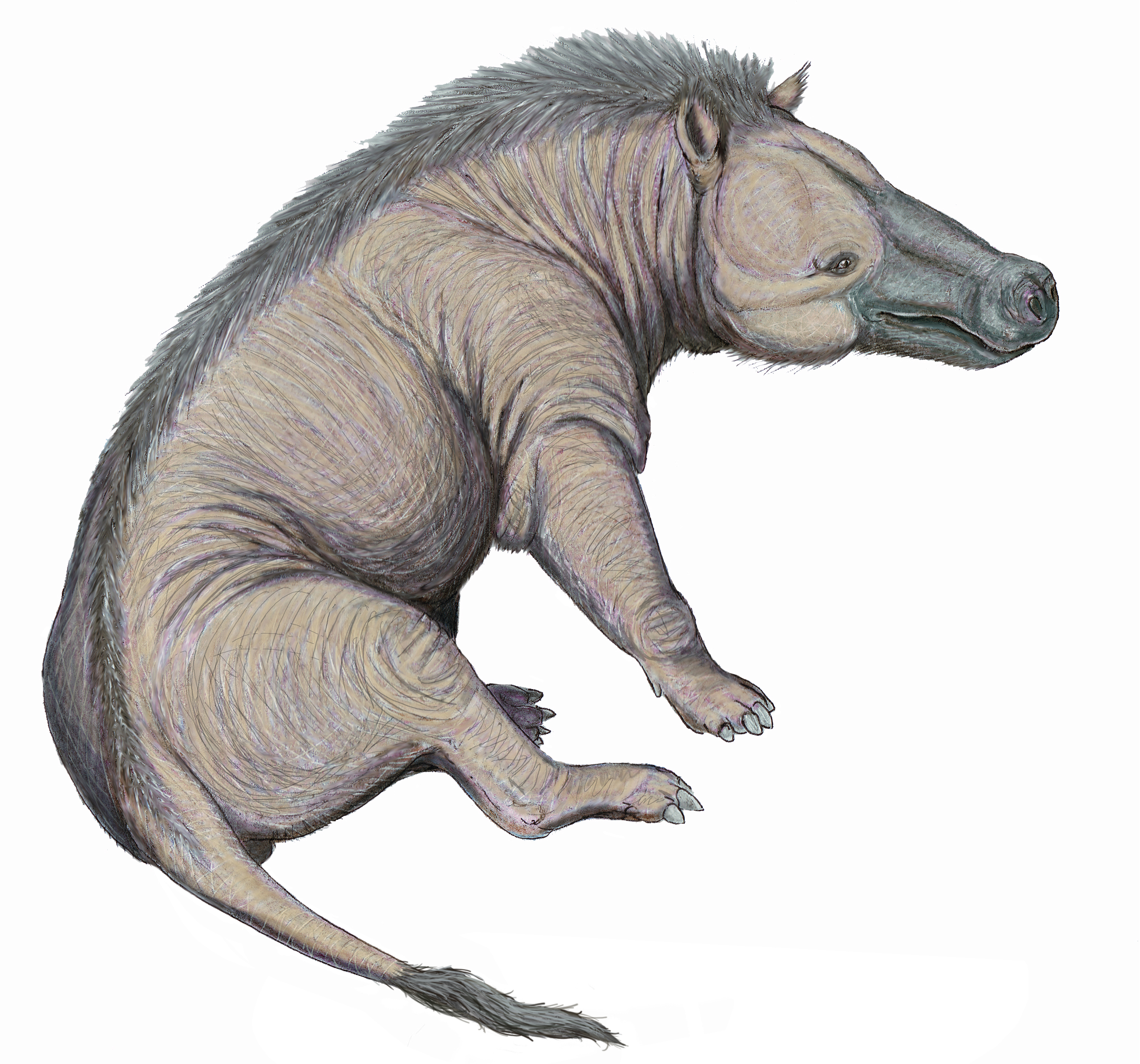|
Telecrex
''Telecrex'' is an extinct genus of birds related to guineafowl, containing two species, ''Telecrex grangeri'' (the type species) and ''Telecrex peregrinus''. ''T. grangeri'' is known from a single partial femur from Eocene deposits in Inner Mongolia, while ''T. peregrinus'' was found in France. Taxonomy The holotype and only known specimen of ''Telecrex grangeri'', AMNH 2942, is a partial right femur collected from the Eocene Irdin Manha Formation. The distal end and part of the trochanter are missing. The new genus ''Telecrex'' was described by Wetmore in 1934 and assigned to the Rallidae. In 1974, the holotype was reexamined by Storrs Olson, who concluded that it was in fact an early relative of guineafowl, a family previously only known from Africa and Europe. The holotype of ''Telecrex peregrinus'', NHMW 1988/28/1 was collected near Lalbenque in Lot, France Lot (; �l is a department in the Occitanie region of France. Named after the Lot River, it lies in the sou ... [...More Info...] [...Related Items...] OR: [Wikipedia] [Google] [Baidu] |
Irdin Manha Formation
The Irdin Manha Formation is a geology, geological formation from the Eocene located in Inner Mongolia, China, a few kilometres south of the Mongolian border.. Retrieved July 2013. Fossil content Mammals U.S. paleontologists Henry Fairfield Osborn and Roy Chapman Andrews, Roy C. Andrews discovered two premolars on the site in 1923, and assigned the specimen to the new genus ''Eudinoceras'' because he believed it to be related to "''Dinoceras''" (now known as ''Uintatherium''). Within a decade, however, as more complete specimens were recovered, the animal was identified as a Mongolian relative to the North American Pantodonta, pantodont ''Coryphodon''. The expedition also lead to the discovery of the only known skull of ''Andrewsarchus''. Artiodactyls Cimolestans Dinoceratans Ferae Glires Mesonychians Perissodactyls Primates Reptiles Birds Crocodilians Testudines Fish See also * List of fossil sites References {{Reflist Geologic formations of ... [...More Info...] [...Related Items...] OR: [Wikipedia] [Google] [Baidu] |
Guineafowl
Guinea fowl () (or guineahen) are birds of the family Numididae in the order Galliformes. They are endemic to Africa and rank among the oldest of the gallinaceous birds. Phylogenetically, they branched off from the core Galliformes after the Cracidae (chachalacas, guans, and curassows) and before the Odontophoridae (New World quail). An Eocene fossil lineage '' Telecrex'' has been associated with guinea fowl; ''Telecrex'' inhabited Mongolia, and may have given rise to the oldest of the true phasianids, such as blood pheasants and eared pheasants, which evolved into high-altitude, montane-adapted species with the rise of the Tibetan Plateau. While modern guinea fowl species are endemic to Africa, the helmeted guinea fowl has been introduced as a domesticated bird widely elsewhere. Taxonomy and systematics This is a list of guinea fowl species, presented in taxonomic order. Phylogeny Cladogram based on a study by De Chen and collaborators published in 2021. Descrip ... [...More Info...] [...Related Items...] OR: [Wikipedia] [Google] [Baidu] |
Rail (bird)
Rails (avian family Rallidae) are a large, Cosmopolitan distribution, cosmopolitan family (biology), family of small- to medium-sized terrestrial and/or semi-amphibious birds. The family exhibits considerable diversity in its forms, and includes such ubiquitous species as the crakes, coots, and gallinule; other rail species are extremely rare or endangered. Many are associated with wetland habitats, some being semi-aquatic like waterfowl (such as the coot), but many more are wading birds or shorebirds. The ideal rail habitats are marsh areas, including rice paddy, rice paddies, and flooded fields or open forest. They are especially fond of dense vegetation for nesting.Horsfall & Robinson (2003): pp. 206–207 The rail family is found in every Terrestrial animal, terrestrial habitat with the exception of dry desert, Polar climate, polar or freezing regions, and Alpine climate, alpine areas (above the snow line). Members of Rallidae occur on every continent except Antarctica. N ... [...More Info...] [...Related Items...] OR: [Wikipedia] [Google] [Baidu] |
Lot (department)
Lot (; �l is a department in the Occitanie region of France. Named after the Lot River, it lies in the southwestern part of the country and had a population of 174,094 in 2019.Populations légales 2019: 46 Lot INSEE Its is Cahors; its subprefectures are and [...More Info...] [...Related Items...] OR: [Wikipedia] [Google] [Baidu] |
Lalbenque
Lalbenque (; ) is a commune in the Lot department in south-western France. See also *Communes of the Lot department The following is a list of the 312 communes of the Lot department of France France, officially the French Republic, is a country located primarily in Western Europe. Overseas France, Its overseas regions and territories include French Gu ... References Communes of Lot (department) Quercy {{Lot-geo-stub ... [...More Info...] [...Related Items...] OR: [Wikipedia] [Google] [Baidu] |
Natural History Museum, Vienna
The Natural History Museum Vienna () is a large natural history museum located in Vienna, Austria. The NHM Vienna is one of the largest museums and non-university research institutions in Austria and an important center of excellence for all matters relating to natural sciences. The museum's 39 exhibition rooms cover 8,460 square meters and present more than 100,000 objects. It is home to 30 million objects available to more than 60 scientists and numerous guest researchers who carry out basic research in a wide range of topics related to human sciences, earth sciences, and List of life sciences, life sciences. The ''Index Herbariorum'' code assigned to this museum is W and it is used when citing housed herbarium specimens. History The earliest collections of the Natural History Museum Vienna date back more than 250 years. It was the Holy Roman Emperor Francis I, Holy Roman Emperor, Francis I, Maria Theresa’s husband, who in 1750 purchased what was at the time the world's ... [...More Info...] [...Related Items...] OR: [Wikipedia] [Google] [Baidu] |
Europe
Europe is a continent located entirely in the Northern Hemisphere and mostly in the Eastern Hemisphere. It is bordered by the Arctic Ocean to the north, the Atlantic Ocean to the west, the Mediterranean Sea to the south, and Asia to the east. Europe shares the landmass of Eurasia with Asia, and of Afro-Eurasia with both Africa and Asia. Europe is commonly considered to be Boundaries between the continents#Asia and Europe, separated from Asia by the Drainage divide, watershed of the Ural Mountains, the Ural (river), Ural River, the Caspian Sea, the Greater Caucasus, the Black Sea, and the waterway of the Bosporus, Bosporus Strait. "Europe" (pp. 68–69); "Asia" (pp. 90–91): "A commonly accepted division between Asia and Europe ... is formed by the Ural Mountains, Ural River, Caspian Sea, Caucasus Mountains, and the Black Sea with its outlets, the Bosporus and Dardanelles." Europe covers approx. , or 2% of Earth#Surface, Earth's surface (6.8% of Earth's land area), making it ... [...More Info...] [...Related Items...] OR: [Wikipedia] [Google] [Baidu] |
Africa
Africa is the world's second-largest and second-most populous continent after Asia. At about 30.3 million km2 (11.7 million square miles) including adjacent islands, it covers 20% of Earth's land area and 6% of its total surface area.Sayre, April Pulley (1999), ''Africa'', Twenty-First Century Books. . With nearly billion people as of , it accounts for about of the world's human population. Demographics of Africa, Africa's population is the youngest among all the continents; the median age in 2012 was 19.7, when the worldwide median age was 30.4. Based on 2024 projections, Africa's population will exceed 3.8 billion people by 2100. Africa is the least wealthy inhabited continent per capita and second-least wealthy by total wealth, ahead of Oceania. Scholars have attributed this to different factors including Geography of Africa, geography, Climate of Africa, climate, corruption, Scramble for Africa, colonialism, the Cold War, and neocolonialism. Despite this lo ... [...More Info...] [...Related Items...] OR: [Wikipedia] [Google] [Baidu] |
Family (taxonomy)
Family (, : ) is one of the eight major hierarchical taxonomic ranks in Linnaean taxonomy. It is classified between order and genus. A family may be divided into subfamilies, which are intermediate ranks between the ranks of family and genus. The official family names are Latin in origin; however, popular names are often used: for example, walnut trees and hickory trees belong to the family Juglandaceae, but that family is commonly referred to as the "walnut family". The delineation of what constitutes a family—or whether a described family should be acknowledged—is established and decided upon by active taxonomists. There are not strict regulations for outlining or acknowledging a family, yet in the realm of plants, these classifications often rely on both the vegetative and reproductive characteristics of plant species. Taxonomists frequently hold varying perspectives on these descriptions, leading to a lack of widespread consensus within the scientific community fo ... [...More Info...] [...Related Items...] OR: [Wikipedia] [Google] [Baidu] |
Storrs L
Storrs may refer to: * Storrs (surname) * Storrs, Connecticut Storrs ( ) is a village and census-designated place (CDP) in the New England town, town of Mansfield, Connecticut, Mansfield in eastern Tolland County, Connecticut, United States. The village is part of the Capitol Planning Region, Connecticut, ..., a village where the main campus of the University of Connecticut is located ** Charles and Augustus Storrs, founders of the University of Connecticut and namesakes of the village * Storrs Township, Hamilton County, Ohio * Storrs, South Yorkshire, a rural hamlet within the City of Sheffield, England * Storrs, Cumbria See also * Storrs Hall, a listed building in Cumbria, England * Yealand Storrs, a hamlet in the English county of Lancashire * Storr {{disambiguation, geo ... [...More Info...] [...Related Items...] OR: [Wikipedia] [Google] [Baidu] |
Genus
Genus (; : genera ) is a taxonomic rank above species and below family (taxonomy), family as used in the biological classification of extant taxon, living and fossil organisms as well as Virus classification#ICTV classification, viruses. In binomial nomenclature, the genus name forms the first part of the binomial species name for each species within the genus. :E.g. ''Panthera leo'' (lion) and ''Panthera onca'' (jaguar) are two species within the genus ''Panthera''. ''Panthera'' is a genus within the family Felidae. The composition of a genus is determined by taxonomy (biology), taxonomists. The standards for genus classification are not strictly codified, so different authorities often produce different classifications for genera. There are some general practices used, however, including the idea that a newly defined genus should fulfill these three criteria to be descriptively useful: # monophyly – all descendants of an ancestral taxon are grouped together (i.e. Phylogeneti ... [...More Info...] [...Related Items...] OR: [Wikipedia] [Google] [Baidu] |
1934 In Paleontology
Arthropods Insects Conodonts Reptiles Dinosaurs Newly named dinosaurs Data courtesy of George Olshevsky's dinosaur genera list. Synapsids Non-mammalian Mammals References {{portal, Paleontology [...More Info...] [...Related Items...] OR: [Wikipedia] [Google] [Baidu] |







